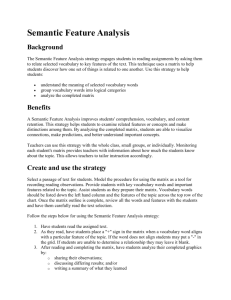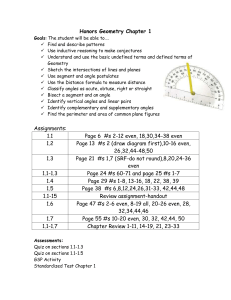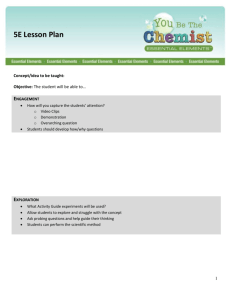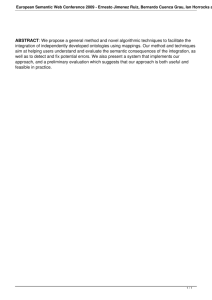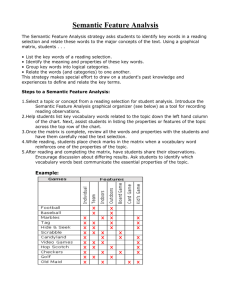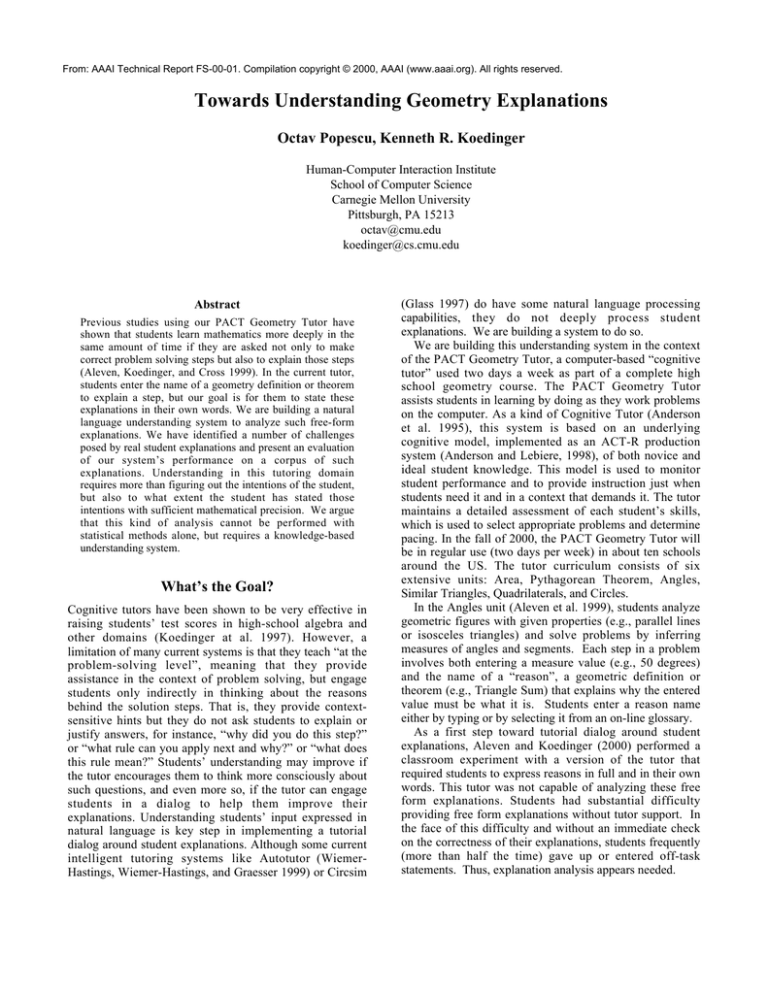
From: AAAI Technical Report FS-00-01. Compilation copyright © 2000, AAAI (www.aaai.org). All rights reserved.
Towards Understanding Geometry Explanations
Octav Popescu, Kenneth R. Koedinger
Human-Computer Interaction Institute
School of Computer Science
Carnegie Mellon University
Pittsburgh, PA 15213
octav@cmu.edu
koedinger@cs.cmu.edu
Abstract
Previous studies using our PACT Geometry Tutor have
shown that students learn mathematics more deeply in the
same amount of time if they are asked not only to make
correct problem solving steps but also to explain those steps
(Aleven, Koedinger, and Cross 1999). In the current tutor,
students enter the name of a geometry definition or theorem
to explain a step, but our goal is for them to state these
explanations in their own words. We are building a natural
language understanding system to analyze such free-form
explanations. We have identified a number of challenges
posed by real student explanations and present an evaluation
of our system’s performance on a corpus of such
explanations. Understanding in this tutoring domain
requires more than figuring out the intentions of the student,
but also to what extent the student has stated those
intentions with sufficient mathematical precision. We argue
that this kind of analysis cannot be performed with
statistical methods alone, but requires a knowledge-based
understanding system.
What’s the Goal?
Cognitive tutors have been shown to be very effective in
raising students’ test scores in high-school algebra and
other domains (Koedinger at al. 1997). However, a
limitation of many current systems is that they teach “at the
problem-solving level”, meaning that they provide
assistance in the context of problem solving, but engage
students only indirectly in thinking about the reasons
behind the solution steps. That is, they provide contextsensitive hints but they do not ask students to explain or
justify answers, for instance, “why did you do this step?”
or “what rule can you apply next and why?” or “what does
this rule mean?” Students’ understanding may improve if
the tutor encourages them to think more consciously about
such questions, and even more so, if the tutor can engage
students in a dialog to help them improve their
explanations. Understanding students’ input expressed in
natural language is key step in implementing a tutorial
dialog around student explanations. Although some current
intelligent tutoring systems like Autotutor (WiemerHastings, Wiemer-Hastings, and Graesser 1999) or Circsim
(Glass 1997) do have some natural language processing
capabilities, they do not deeply process student
explanations. We are building a system to do so.
We are building this understanding system in the context
of the PACT Geometry Tutor, a computer-based “cognitive
tutor” used two days a week as part of a complete high
school geometry course. The PACT Geometry Tutor
assists students in learning by doing as they work problems
on the computer. As a kind of Cognitive Tutor (Anderson
et al. 1995), this system is based on an underlying
cognitive model, implemented as an ACT-R production
system (Anderson and Lebiere, 1998), of both novice and
ideal student knowledge. This model is used to monitor
student performance and to provide instruction just when
students need it and in a context that demands it. The tutor
maintains a detailed assessment of each student’s skills,
which is used to select appropriate problems and determine
pacing. In the fall of 2000, the PACT Geometry Tutor will
be in regular use (two days per week) in about ten schools
around the US. The tutor curriculum consists of six
extensive units: Area, Pythagorean Theorem, Angles,
Similar Triangles, Quadrilaterals, and Circles.
In the Angles unit (Aleven et al. 1999), students analyze
geometric figures with given properties (e.g., parallel lines
or isosceles triangles) and solve problems by inferring
measures of angles and segments. Each step in a problem
involves both entering a measure value (e.g., 50 degrees)
and the name of a “reason”, a geometric definition or
theorem (e.g., Triangle Sum) that explains why the entered
value must be what it is. Students enter a reason name
either by typing or by selecting it from an on-line glossary.
As a first step toward tutorial dialog around student
explanations, Aleven and Koedinger (2000) performed a
classroom experiment with a version of the tutor that
required students to express reasons in full and in their own
words. This tutor was not capable of analyzing these free
form explanations. Students had substantial difficulty
providing free form explanations without tutor support. In
the face of this difficulty and without an immediate check
on the correctness of their explanations, students frequently
(more than half the time) gave up or entered off-task
statements. Thus, explanation analysis appears needed.
This paper reports on our progress toward a natural
language understanding system that can analyze student
explanations. In particular, the system must distinguish
among a variety of explanation attempts including those
that: are correct and complete, express the right idea but
incompletely or imprecisely, are partially correct but
include incorrect information, are stated correctly but are
inappropriate for the current step, and are totally wrong.
Because correct mathematical reasons are expressed in
general and unambiguous terms, the system cannot employ
knowledge of the context of the student’s explanation in
analyzing its correctness. Although context knowledge is
available, it is pedagogically important that students state
reasons unambiguously as such precision is a key
instructional goal. Thus our system must detect correct
reasons without making use of context information.
In many natural language understanding domains, it is
sufficient to understand the intention of the speaker or
writer, for instance, in processing information requests.
However, in tutoring domains it is important to not only
assess whether students appear to have the right idea, but
also whether they can articulate this idea in full. In other
words, does the student understand the crucial components
of the idea that delineate when and how it applies and
when it does not? Unlike information retrieval, we argue
that natural language understanding of this kind cannot be
performed with statistical methods alone, but requires a
knowledge-based understanding system.
In the following section we describe a corpus of student
explanations we have collected that has guided our initial
development. We describe the challenges posed by real
student explanations and overview the strategies we have
implemented to address these challenges. Next, we discuss
why knowledge-based understanding is particularly
appropriate in this domain. We then describe how the
system works in more detail. Finally, we present a
preliminary evaluation of the system’s performance
relative to a human grader and discuss limitations and next
steps.
Features of the Corpus
As a basis for the development of the system, we collected
a corpus of students’ explanations from written pre- and
post-tests. Those tests were given to students in classes that
also use the PACT Geometry Tutor as part of the course.
Students were given a “Reason Sheet” which provided
names and a sentence description of 19 geometry
definitions or theorems. Students were asked to provide an
explanation for each step in each problem. The different
test forms had about 21 steps on them, so we collected
about 21 explanations per student. The data comes from
100 students who took either or both the pre-test and the
post-test. Our corpus included a total of 2333 explanations.
Table 1 shows these explanations categorized into 6 broad
categories. These categories are:
•
Blank: No explanation was provided.
•
•
•
•
•
Procedural Replay: The explanation only restated the
operations performed in computing the value.
Reason: The explanation consisted of a more or less
complete sentence stating the actual theorem.
R e f e r e n c e : The explanation named one of the
theorems in the reason sheet.
Procedural Replay & Reason: The explanation
included a combination of a procedural replay and a
reason.
Procedural Replay & Reference: The explanation
included a combination of a procedural replay and a
reference.
The %Correct column in Table 1 shows what percentage
of the explanations in the respective category were judged
correct by a human grader. This judgement includes both
an evaluation of how good the sentence was as an
expression of the intended reason, and of how appropriate
the intended reason was as an explanation for the particular
value it was associated with. Table 2 shows examples of
student explanations.
Table 1. Categories of student explanations, their
frequency, and percent correct.
Count Frequency %Correct
Blank
255
10.9%
0%
Procedural Replay
117
5.0%
0%
Reason
676
30%
23%
Reference
1196
51%
56%
Proc. Replay & Reason
60
2.6%
70%
Proc. Replay & Ref.
29
1.2%
79%
Grand Total
2333
45%
Table 2. Examples of student explanations of steps
where “Linear pair” is the correct reason.
Procedural
Replay
Procedural
Replay &
Reason
Procedural
Replay &
Reference
Reason
Reference
Correct
[none]
180-118 because
linears add up
to 180
linear pair 180-107
the sum of the
measures of a
linear pair of
angles is 180
degrees.
because it's a
linear pair.
Incorrect
I took 107 and
subtracted it
from 180
180-118=62 for
straight line
[none]
linear pairs =
180
isosceles
triangle
Our NLU development has so far focused on
understanding student attempts at “Reasons”, thus we have
been investigating the 676 instances of Reason attempts in
the corpus.
Challenges and How They Were Addressed
The corpus presents numerous problems for building a
semantic representation that models the logical meaning of
sentences. Key challenges are described below. We also
provide an overview of the solutions we are developing. In
the section following, we provide more detail on how our
natural language understanding system works.
Number agreement:
Example: The angles is congruent.
Students often mismatch number markings of nouns,
pronouns, and verbs. While relaxing the grammar to
allow for such inconsistencies is not a problem, the
semantic representation is another issue. The
representation of a singular noun should be as a single
item of the appropriate class, while that of a plural
noun should be a set of such items. Since the system
does not know which one is wrong, it cannot
consistently rely on number information in either the
noun or the verb for this choice. The current solution
gives priority to information in the noun but at the
same time uses a “lazy” strategy in building the sets
corresponding to plural nouns, instantiating them only
when needed based on semantic constrains of related
concepts.
Plurals:
Example: A pair of vertical angles
formed by intersecting lines are
congruent.
Even if the subject is singular, the verb is in plural
form. However the sentence has a valid meaning,
because the subject represents a set of objects, while
the predicate expresses a relation among these objects
that are the elements of the set. Then, in case of
subjects that represent sets, the system chooses, based
on the semantic features of the properties involved
(“congruent”), whether to assert the property on
the set itself or on its elements.
Distributive versus collective reading:
Example: The angles in a triangle are
180 degrees.
Is this property asserted about each of the angles in the
set (e.g., if 180 were 60) or about the sum of their
measures? That is, is this a distributive property or a
collective property? One solution is to both build the
distributive reading whenever semantic constraints
allow the property to be asserted on the elements of
referenced set and build the collective reading
whenever the set of elements forms a structure that has
the asserted property well defined for it. Further
developments could involve making a choice based on
plausible ranges of values. Ambiguities that remain
are ideal candidates for tutorial dialog: “is every angle
in a triangle equal to 180 degrees?”.
Metonymy:
Example: The sum of a linear pair of
angles is 180.
Metonymy is the phenomenon of imprecise reference
whereby a technically incorrect concept is used as a
shortcut for the correct concept (e.g., “New York
called” to indicate the guy from New York called). In
the example above, it is technically incorrect to add
angles, but “angles” is a shortcut for “the measures of
the angles”. The complete phrase is: “sum of the
measures of the angles in a linear
pair ”. The difficulty is not so much building a
semantic structure where angles are added instead of
measures, but rather in recognizing that this structure
is logically equivalent to adding measures. The
problem is composed here with the previous problem
of collective vs. distributive reading, because, in order
to get to angles, the system has to first realize the sum
is not a relation over pairs of angles, but over the
elements of this pair. The solution we have so far is to
make the system recognize the failure of a direct
semantic connection between sum and angles, and
then try to build the right semantic representation by
searching for the conceptual link between sum and
angles in the semantic vicinity of the concepts
involved. While the example is frequent enough that
it could be dealt with as a special case, there are
numerous other instances of metonymy in student
explanation attempts.
Anaphora resolution:
Example: If the lengths of two sides
of a triangle are equal, then the
measures of the angles opposite them
will also be equal.
In this example the pronoun “them ” in the main
clause is used as a reference to the set denoted by
“ two sides” in the conditional clause. Without
solving this reference the system won’t be able to
build the right semantic representation for the
sentence. There are however several different
candidate references for binding “them” besides the
right one: “the lengths”, “a triangle”, “the
measures”, and “the angles”. Currently the
system uses a combination of syntactic and semantic
constraints to choose among possible candidates.
However, if two or more candidates still pass those
tests, it will just choose the one that is structurally
closest to the pronoun. In this case, the system will
eliminate “the lengths” and “the measures”,
based on a semantic constraint that geometry objects
cannot oppose measures. And it will eliminate “the
angles” based on the syntactic constraint that a
pronoun has to be free in its local domain. While in
theory “a triangle” could be ruled out based on
number information, the unreliability of number
markings mentioned above makes this more difficult.
Prepositional phrase attachment ambiguity:
Example: The sum of the measures of
the three interior angles in a
triangle is equal to 180 degrees.
While there might be syntactical preferences, there is
no syntactic constraint to prevent the prepositional
phrase “in a triangle” from being attached to
either “the sum”, “the measures”, or “t h e
three interior angles”. However semantic
constraints on the nature of concepts that can be
related by the relation “in” can ensure the correct
choice.
Why Is Knowledge-Based NLU Appropriate
Here?
Statistical-based methods like Latent Semantic Analysis
(e.g., Wiemer-Hastings, Wiemer-Hastings, and Graesser
1999), trigrams, Hidden Markov Models, etc. have been
used for NLU in various applications with various degrees
of success. We believe that a knowledge-based approach
has better chances of success in the context of the current
project for several reasons relating to characteristics of the
task at hand:
• The domain of mathematical discourse has a limited
number of precisely defined concepts and relations
among them. This makes one of the main problems
with knowledge-based approaches, the task of
modeling the domain of discourse in a knowledge
base, much easier than in generic vague domains of
other applications.
• Students’ sentences tend to be rather short, making
many statistical approaches less likely to work well
because of lack of enough information.
• Statistical approaches tend to work fine on the task of
classifying texts as belonging to one of several given
classes. Small changes in the text usually won’t
change the classification. In analyzing students’
explanations, subtle language distinctions might lead
to significant differences in meaning, making
statistical approaches less likely to succeed in
classifying them accordingly.
• Methods that don’t take word order into consideration,
like Latent Semantic Analysis and many text
classification algorithms (e.g., Brüninghaus and
Ashley 1997), will fail to classify properly a rule and
its converse, which are the same bag of words. For
instance, consider the rule “If two angles form
a line, then they sum to 180” and its
converse “If two angles sum to 180,
then they form a line”. The same words are
used in both, but the first is true while the second is
false. As a second example, consider the rule “I f
two
sides
of
a
triangle
are
congruent, then the angles opposite
them are congruent” and its converse “If
two angles of a triangle are
congruent, then the sides opposite
•
them are congruent”. In this case, both rules
are true, but in a given situation only one will be a
correct reason.
Being able to carry out an intelligent dialog with
students about what is wrong and what is right in the
explanations they give necessitates having a precise
representation of the meaning of those explanations,
so that their elements can be analyzed in detail.
Statistical approaches tend not to be able to provide
such representations.
How Does the System Work?
In the current implementation we approach the
understanding of geometry theorems through having them
classified by a description logic system. Thus we aim at
building a unique semantic representation for all sentences
with the same meaning content. This representation should
carry all logical conditions so that it can be recognized by a
logic system as being a valid representation for a given
theorem.
In order to do that, the system uses a parser that takes a
sentence and a grammar and builds a feature structure
representing the syntactic structure of the sentence. At the
same time it issues directives to the logic-based knowledge
representation system to piece together a semantic
representation of the sentence. This representation is then
evaluated by the classifier against definitions of geometry
theorems. The next paragraphs describe the key system
components and their function.
Parser
The parser used currently is LCFlex, a left-corner activechart parser developed at University of Pittsburgh (Rosé
and Lavie 1999). The parser uses a context free formalism
augmented with feature structures. The formalism
originates in a previous GLR* system at Carnegie Mellon
University (Lavie 1995) (Tomita 1988). The parser takes
words of the input sentence one by one, and after a lexicon
lookup, it identifies those rules of the grammar that could
model the current word sequence. It keeps track of the
active rules at any point in time by storing them in a chart
that shows all possible partial parses up to that point.
Grammar
The grammar consists of context free rules accompanied
by equations. The equations specify restrictions on the
feature structures corresponding to the non-terminals of the
rule. The current grammar used in the system follows
loosely the Lexical Functional Grammar theory (Bresnan
1997).
An example of a simplified rule that builds a clause
from a sequence of a noun phrase and a verb phrase is:
(<Cl> <== (<NP> <VP>)
((x0 = x2)
((x0 subject) = x1)
(*test* (connect-instances
(x0 sem content)
(x0 subject sem-role)
(x0 subject sem content)))))
Grammar rules also include calls that direct the logic
system to build the semantic representation. The rule above
shows such a call (connect-instances) that will
connect the semantic representations of the elements
through a binary relation specified by the subject’s
semantic role for the current predicate.
Knowledge Representation
The system uses Loom (MacGregor 1991) (Brill 1993)
both to express knowledge about the domain of discourse
and to build semantic representations of natural language
sentences. Knowledge about the domain of discourse is
represented as Loom definitions and productions. Those
serve the purpose of axioms in a logic language.
The semantic representation of natural language
sentences is expressed in terms of Loom assertions over
Loom instances. Loom instances are used to represent
discourse referents and play the role of variables in first
order logic. Assertions correspond to predicates.
Loom provides deductive support for declarative
knowledge expressed as definitions through a description
classifier (MacGregor 1991). The classifier utilizes
forward-chaining, semantic unification and object-oriented
truth maintenance technologies to dynamically infer
conceptual affiliation of instances based on given
definitions.
As an illustration, a simplified version of the concept
definitions necessary for building a semantic representation
of the statement:
The measure of a right angle is 90
degrees.
is:
(defconcept Measure
:is-primitive Abstraction)
(defconcept Measure-Unit
:is (:one-of 'degree 'rad
'meter 'centimeter))
(defconcept Geometry-Measure
:is (:and Measure
(:the value Number)
(:the unit Measure-Unit))
(defconcept Geometry-Object
:is-primitive
(:and Abstraction
(:all Measure Geometry-Measure)))
(defproperty Right
:is-primitive Quality
:domain Geometry-Object)
(defconcept Angle-Measure
:is (:and Geometry-Measure
(:the unit
(:one-of 'degree 'rad))))
(defconcept Angle
:is-primitive
(:and Geometry-Object
(:the measure Angle-Measure)))
(defconcept Being&Having
:is-primitive Configuration)
(defconcept Ascription
:is (:and Being&Having
(:exactly 1 attribuend)
(:the attribute Measure))
(defproduction ascription
:when (:detects (Ascription ?x))
:do ((combine-instances
(get-value ?x 'attribute)
(get-value ?x 'attribuend))))
Based on these definitions, the parser creates the
following Loom instances to stand for the discourse
referents introduced by the subject and the verb phrase:
(tell (:about measure-1
(:create Measure)
(belongs-to angle-2)
(measure-of angle-2)))
(tell (:about angle-2
(:create Angle)
right
(measure measure-1)))
(tell (:about measure-4
(:create Measure)
(unit ‘degree)
(value 90)))
(tell (:about being&having-3
(:create Being&Having)
(attribute measure-4)))
Then, when applying the grammar rule for clauses given
above, and considering information about verb arguments
found in the lexical entry for the verb “be ”, the parser
issues the command:
(connect-instances ‘being&having-3
‘attribuend ‘measure-1)
The “c o n n e c t - i n s t a n c e s “ function checks
whether it makes semantic sense for the attribuend “the
measure of an angle” to have the attribute “90
degrees”. In this case it does. (For a sentence like “the
measure of an angle is blue”, Loom would
find a semantic inconsistency between the arguments and
will fail the analysis). Loom then modifies the instance for
“be“ above to:
(tell (:about being&having-3
(:create Being&Having)
(attribute measure-4)
(attribuend measure-1))
Then the Loom classifier recognizes this instance as
having all necessary elements to belong to concept
“Ascription”, and fires the production rule associated
with it. This production rule then issues the command:
(combine-instances ‘measure-4
‘measure-1)
The effect is to actually combine the two instances into a
single one, and thus create the structure that models the
assertion in the sentence:
(tell (:about measure-1
(:create Measure)
(belongs-to angle-2)
(measure-of angle-2)))
(unit ‘degree)
(value 90)))
(tell (:about angle-2
(:create Angle)
right
(measure measure-1)))
(tell (:about being&having-3
(:create Being&Having)
(attribute measure-1)
(attribuend measure-1))
If given a concept definition for what constitutes a valid
statement for the right angle theorem, as below, Loom will
then classify the instance “being&having-3” above as
belonging to this concept.
(defconcept Right-Angle-Reason
:is (:and Ascription
(:the attribuend
(:and Measure
(:the measure-of
(:and Angle Right)))
(:the attribute
(:the value 90))))
Progress So Far and Limitations
As a preliminary evaluation of the current status of the
system, we have tested it on the 676 statements in the
corpus on the task of simply accepting or rejecting the
students’ statements. Of these, the system classifies
successfully 402 statements in the sense that its
classification matches the classification of a human grader,
or the reason was incorrect and rejected. Of these, 143 are
a correct reason and 259 are incorrect. The incorrect
reasons were classified so either because the student stated
an incorrect reason or the student’s attempt at the correct
reason was incorrect or incomplete. The system
misclassifies only 7 reasons that were considered correct
by the human grader. 267 other statements are not
classified. Of these, most (264) are incorrect, and very few
(3) are correct. Table 3 summarizes the results of the
comparison of the system with the human grader.
Table 3. Comparison of the system with a human
grader
Grader’s Judgment
System’s
Reason
Reason
Judgment
Correct
Incorrect
Reason
143 (21%)
0 (0%)
Correct
Reason
7 (1%) 259 (38%)
Incorrect
No
3 (0.5%) 264 (39%)
Class
However the threshold for correctness in this test was set
very high. Many of the incorrect statements are not
necessarily totally incorrect, but rather incomplete or
imprecisely stated. A strict teacher might say that these are
indeed incorrect, but this same teacher would be able to
recognize that these sentences are close to expressing a
valid reason. While teachers may not totally accept such
reasons, they would not totally reject them, but rather
engage in a dialog to help the student refine them.
Examples of these imprecise reasons are:
All angles in a triangle = 180.
The sum of the measures of the 3 int.
of a tri. are 180.
The sum of the triangle has to equal
180.
2 and 4 are same angles, linears add up
to 180.
Because a line has to equal 180.
Some of these sentences introduce new challenges for the
process of building a semantic representation. The main
problem is that in many of these cases the parse fails
because of either syntactic constraints in the grammar (e.g.,
the adjective “linear” is used as a noun), or semantic
constraints in the knowledge base (e.g., a line is given an
angle measure). Solving such problems will require finding
ways to relax those constraints when needed, but still
enforce them in most cases.
What we want to achieve is to be able to distinguish
solid-hits from near-hits from near-misses from total
misses. And further to be able to change the correctness
criteria by moving a partial reason either in or out of the
list of acceptable reasons for a step.
We currently use the Loom classifier to tell us when the
semantic representation of a natural language sentence
constitutes a valid expression of a geometry theorem. In
order to be able to also recognize when a given sentence is
a near-hit under this approach, we have to build descriptive
concepts of all the partial reasons we want to recognize.
Currently we have already defined such a set of partial
reasons. However it may not be reasonable to try to predict
all different ways a student might miss a complete reason.
A more general approach would be to develop a
comparison algorithm. It would take the semantic
representation of a student’s sentence and a concept
description of the target geometry theorem and would
return differences between the two, in terms of missing
and/or wrong assertions.
Conclusion and Next Steps
Previous versions of our PACT Geometry Tutor were able
to recognize students’ reasons only as names of or
references to a set of predefined reasons. This paper
describes a natural language system that is capable of
understanding students’ reasons expressed in free-form
natural language. Recently we created a prototype version
of the tutor that integrates this natural language
understanding system and provides simple feedback on
students’ free-form explanations. We see this as a first
step towards building tutors with full dialog capabilities.
At this point our natural language understanding system
demonstrated reasonable performance on an early test of
accepting/rejecting reasons. However much remains to be
done in order to be able to correctly recognize partially
correct statements of the same reasons.
Among the immediate developments we plan to work on
are:
• Continue to improve the coverage of the system’s
grammar and semantics.
• Collect a corpus of explanations generated in the
context of using the tutor in normal class sessions.
• Create more partial concept categories.
• Develop tutorial dialog moves to respond to different
classification states (solid-hit, near-hit, near-miss, total
miss).
• Develop an algorithm to give us information about the
differences between partial reasons and correct
reasons.
References
Aleven, V. and Koedinger, K. R. 2000. Toward a tutorial
dialog system that helps students to explain solution steps.
In Proceedings of the AAAI 2000 Fall Symposium on
Building Dialogue Systems for Tutorial Applications,
Menlo Park, CA: AAAI Press.
Aleven, V.; Koedinger, K. R.; and Cross, K. 1999.
Tutoring answer-explanation fosters learning with
understanding. In Lajoie, S. P. and Vivet, M. eds. Artificial
Intelligence in Education, Open Learning Environments:
New Computational Technologies to Support Learning,
Exploration, and Collaboration, Proceedings of AIED-99,
199-206. Amsterdam, Netherlands: IOS Press.
Anderson, J. R.; Corbett, A. T.; Koedinger, K. R.; and
Pelletier, R. 1995. Cognitive tutors: Lessons learned. In
The Journal of the Learning Sciences, 4:167-207.
Anderson, J. R. and Lebiere, C. 1998. The Atomic
Components of Thought. Hillsdale, NJ: Erlbaum.
Bresnan, J. 1997. Lexical-functional syntax. ms, Stanford
University.
Brill, D. 1993. Loom reference manual version 2.0.
University of Southern California.
Brünninghaus, S. and Ashley, K. D. 1997 Finding factors
learning to classify case opinions under abstract fact
categories. In Brantig L. K. ed. Proceedings of the Sixth
International Conference on Artificial Intelligence and
Law, Melbourne, Australia.
Glass, M. 1997. Some phenomena handled by the Circsimtutor version 3 input understander. In Proceedings of the
Tenth International Florida Artificial Intelligence Research
Symposium, Daytona Beach, FL.
Lavie, A. 1995. A grammar based robust parser for
spontaneous speech. P h . D . diss., Carnegie Mellon
University.
Koedinger, K. R. and Anderson, J. R. 1993. Reifying
implicit planning in geometry. In S. Lajoie and S. Derry
eds. Computers as Cognitive Tools, 15-45. Hillsdale, NJ:
Erlbaum.
Koedinger, K. R.; Anderson, J. R.; Hadley, W. H.; and
Mark, M. A. 1997. Intelligent tutoring goes to school in the
big city. In International Journal of Artificial Intelligence
in Education, 8:30-43.
MacGregor R. 1991. Using a description classifier to
enhance deductive inference. In Proceedings of the
Seventh IEEE Conference on AI Applications, 141-147.
Miami, FL.
NCTM 1989. Curriculum and Evaluation Standards for
School Mathematics. National Council of Teachers of
Mathematics. Reston, VA: The Council.
Rosé, C. P. and Lavie, A. 1999. LCFlex: An efficient
robust left-corner parser, User’s manual, University of
Pittsburgh.
Tomita, M. 1988. The generalized LR parser/compiler.
User’s guide, Carnegie Mellon University.
Wiemer-Hastings, P.; Wiemer-Hastings, K.; and Graesser,
A. C. 1999. Improving an intelligent tutor’s comprehension
of students with latent semantic analysis. In Lajoie, S. P.
and Vivet, M. eds. Artificial Intelligence in Education,
Open Learning Environments: New Computational
Technologies to Support Learning, Exploration, and
Collaboration, Proceedings of AIED-99, 535-542.
Amsterdam, Netherlands: IOS Press.

